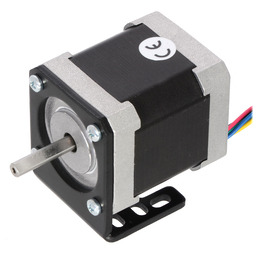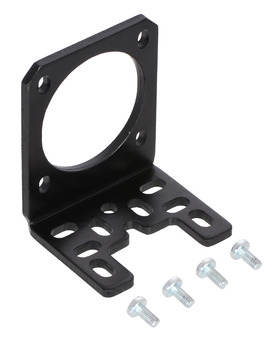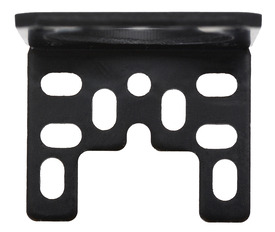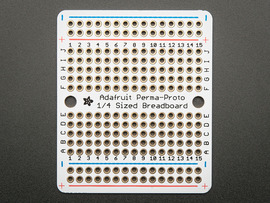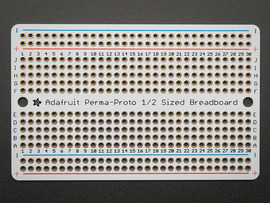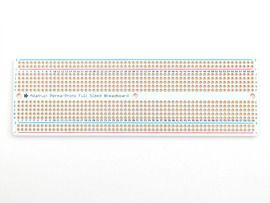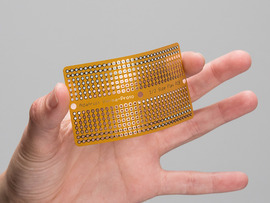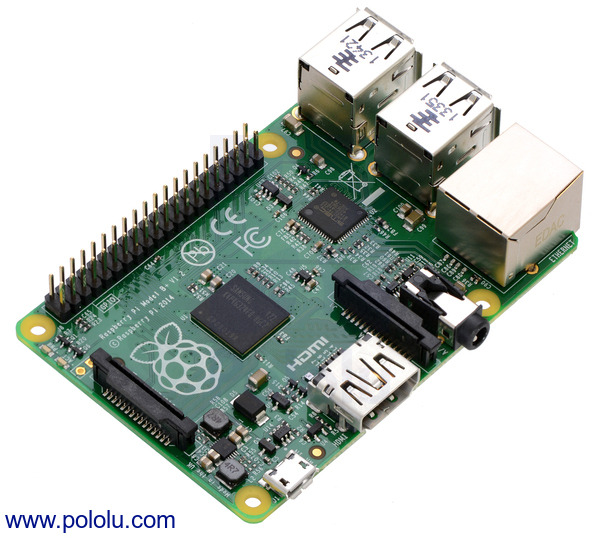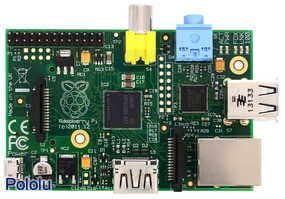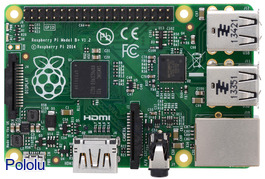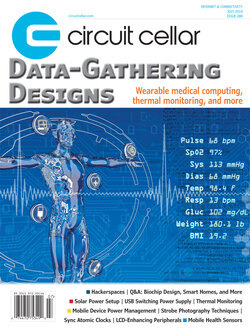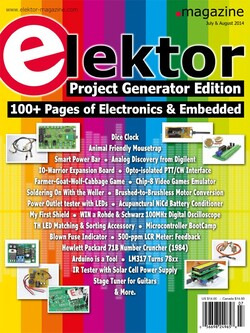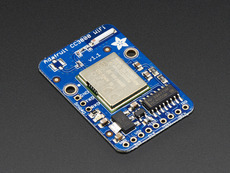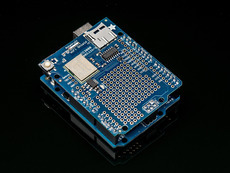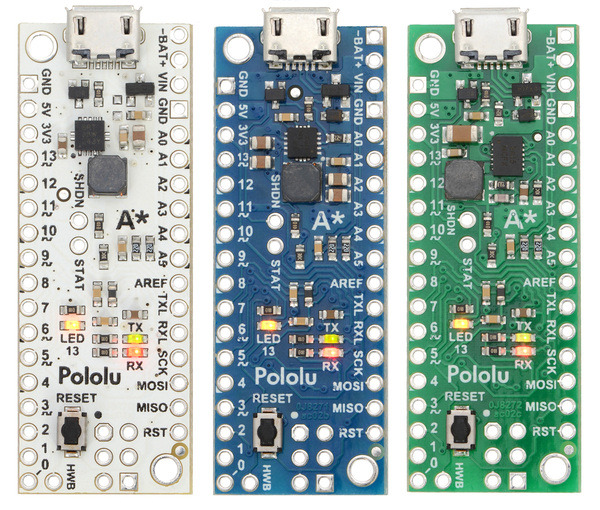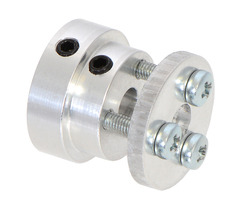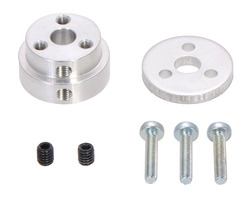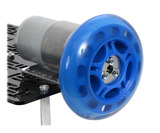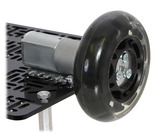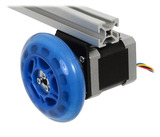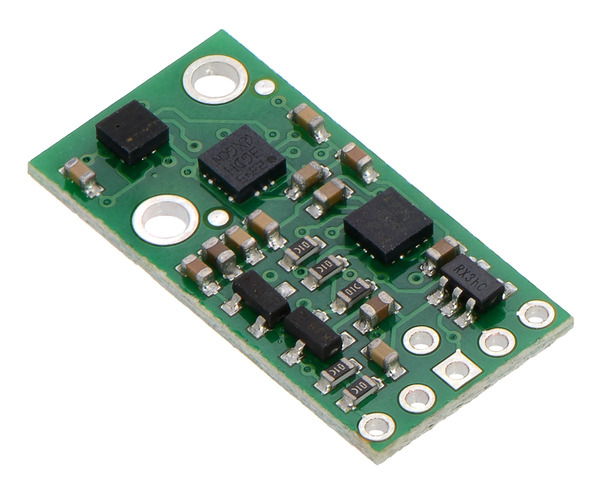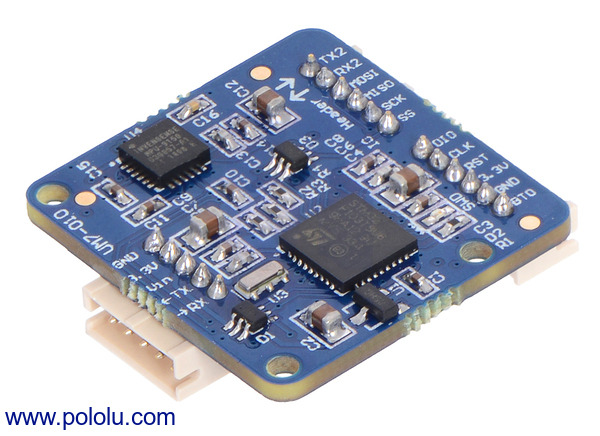Pololu Blog » Posts tagged “new products” »
Posts tagged “new products” (Page 26)
You are currently viewing a selection of posts from the Pololu Blog. You can also view all the posts.
Popular tags: community projects new products raspberry pi arduino more…
New product: Aluminum mounting bracket for NEMA 17 stepper motors
|
|
Our new stepper motor bracket is designed to work with typical NEMA 17-size stepper motors like our 42×48mm and 42×38mm units (including our 42×38mm stepper motor with 28cm lead screw). It is made from 3mm-thick black anodized aluminum, which makes it both light and strong, and slot cutouts allow for plenty of mounting flexibility.
|
|
For more information, see the product page.
New products: Perma-Proto breadboard PCBs from Adafruit
Securely connecting and mounting the electronics for your robot or other project is a key step in taking it from a prototype to a finished design. These perma-proto boards from Adafruit use the same basic through-hole layout as standard solderless breadboards while allowing for permanent solder connections, which makes it easy to transfer your electronics from one to the other.
We are now carrying four types of perma-proto boards:
The quarter-size perma-proto board, at 1.7″ × 2.0″, is slightly larger than a 170-point breadboard and has labels, 15 rows of pins, and two mounting holes.
|
|
The half-size perma-proto board is 3.2″ × 2.0″, which is about the same size as our 400-point beardboard, and has labels, 30 rows of pins, and two mounting holes.
The full-size perma-proto board is similar in size to our 830-point breadboard. It measures 6.2″ × 2.0″ and has labels, 60 rows of pins, and three mounting holes.
|
|
The flexible perma-proto board is made of a thin polyamide film that allows it to be bent, flexed, and cut to fit your project. This version is 3.1″ × 1.7″ (similar in size to the half-size board) and only 0.005″ thick. It contains 30 rows of pins and three mounting holes.
Each board uses 47 mil (1.2 mm) diameter through holes to accommodate parts with thick leads and is through-plated for strength, which means that the pads are less likely to be ripped of during soldering or rework.
New product: Raspberry Pi Model B+
The Raspberry Pi single-board computer has been around for a little over two years in its original Model A and Model B versions, and in that time, it’s become a very popular platform for electronics experimentation. With many of the same capabilities as a regular desktop or laptop PC, but at a small fraction of the size and cost, the Raspberry Pi offers features like network connectivity and significant processing power for robots and other electronics projects.
|
|
We’re now selling the new Raspberry Pi Model B+, which improves on the Model B in a number of ways:
- More GPIO pins are available on a 40-pin header; the Model B has a 26-pin GPIO header.
- The number of USB host ports has been doubled to four.
- Switching regulators lower the power consumption of the Model B+ by 0.5 W to 1 W compared to the Model B (which uses linear regulators), while audio is improved by a dedicated low-noise power supply.
- A much smaller microSD card socket replaces the previous full-size SD card socket.
- Audio and composite video output are combined on the 3.5 mm jack, and many of the connectors extend much less past the edge of the board (as does the inserted microSD card).
- Four mounting holes provide more flexibility in mounting the Model B+.
We’ve seen our customers build lots of cool projects with the Raspberry Pi, including a wirelessly-controlled Zumo robot with a video camera and a robotic ping-pong ball collector. We look forward to seeing what you’ll do with the Model B+!
Free magazines: July 2014 Circuit Cellar and July/August 2014 Elektor
|
|
Get FREE copies of Circuit Cellar magazine’s July issue and Elektor magazine’s July/August issue with your order, while supplies last. To get your free issues, enter the coupon codes CIRCUIT0714 and ELEKTOR0714 into your shopping cart. The Circuit Cellar magazine will add 6 ounces and the Elektor magazine will add 9 ounces to the package weight when calculating your shipping options.
For back issues and more information, see our free Circuit Cellar magazine offers and free Elektor magazine offers.
New products: CC3000 Wi-Fi breakout board and Arduino shield from Adafruit
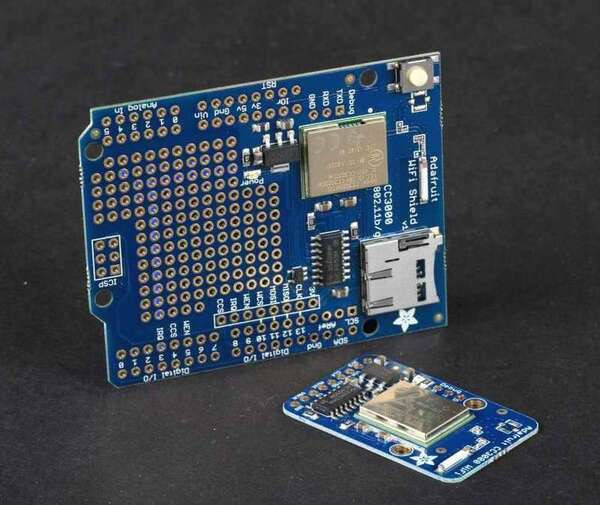 |
Adding wireless connectivity to an electronics project is a great way to enhance functionality and make it stand out. Our selection of wireless electronics includes radio frequency modules, such as the Wixel, and Bluetooth modules, like the BlueSMiRF Silver from SparkFun, but until recently, we did not carry a good solution to adding Wi-Fi to a project. That’s where the newest additions to our wireless selection come into play.
We are now carrying two CC3000 Wi-Fi module carrier boards from Adafruit: the CC3000 Wi-Fi Shield for Arduino and CC3000 Wi-Fi breakout board. The CC3000 is a self-contained wireless network processor with an SPI interface, so it is not limited to a fixed UART baud rate, and the Adafruit carrier boards include level shifters, so they should be simple to connect to almost any microcontroller. Adafruit’s CC3000 Arduino library and example sketches make them especially easy to use with an Arduino-compatible board.
|
|
The CC3000 Wi-Fi Shield for Arduino offers a MicroSD card socket, a prototyping area for soldering extra circuitry, and a button for resetting the Arduino. The CC3000 Wi-Fi breakout board (v1.1) is much more compact and is also breadboard-compatible. Both products include an onboard ceramic antenna.
New products: A-Star 32U4 Minis
A few months ago, we released the A-Star 32U4 Micro, a general-purpose microcontroller breakout board based on the Atmel ATmega32U4, and we discussed our plans to extend the design with additional integrated features. Today, we are thrilled to announce a major expansion of the family with the introduction of the A-Star 32U4 Mini ULV, A-Star 32U4 Mini LV, and A-Star 32U4 Mini SV.
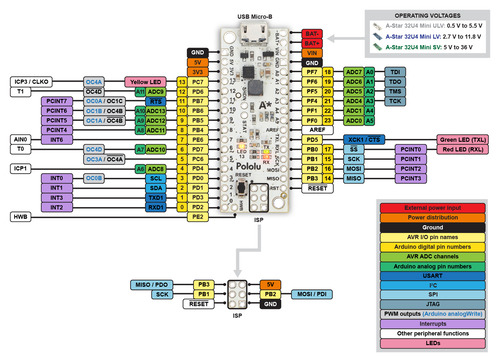 |
A-Star 32U4 Mini pinout diagram (listed SV voltage range is for original ac02c version). |
|---|
Like the A-Star Micro, the A-Star Minis are Arduino-compatible boards based on the ATmega32U4. The Minis are expanded boards that provide access to almost all of the pins of the AVR (including a few more than the Arduino Leonardo and Arduino Micro), but what really sets them apart from competing products are their efficient power supply systems based on switching regulators. Each model is based on a different voltage regulator, and its name includes a designation corresponding to its input voltage range:
- A-Star 32U4 Mini ULV (Ultra-Low Voltage): 0.5 V to 5.5 V
- A-Star 32U4 Mini LV (Low Voltage): 2.7 V to 11.8 V
- A-Star 32U4 Mini SV (Standard Voltage): 5 V to 36 V
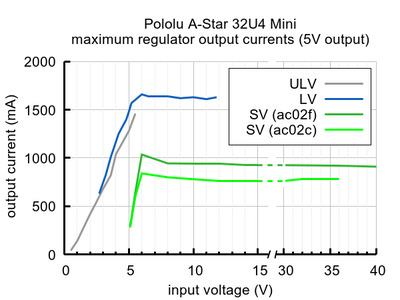 |
Typical maximum output current of the regulators on the A-Star 32U4 Mini boards. |
|---|
The regulator designs are closely related to some of our favorite voltage regulator boards, the U1V11F5, S7V8F5, and D24V5F5. Taken together, this range of options lets you power your project with anything from a single NiMH cell to a 24 V lead-acid battery or an 8-cell LiPo pack. With typical currents of 500 mA to 1 A, you get plenty of 5 V power for your AVR and an array of peripheral devices, or at the other end of the scale, these regulators allow your project to make effective use of low-power modes on the AVR, potentially operating on a battery for months at a time.
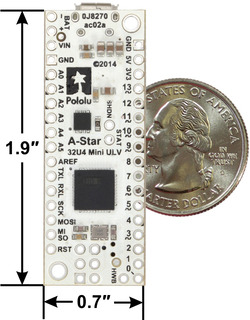 |
A-Star 32U4 Mini ULV, bottom view with dimensions. |
|---|
Another exciting feature of the power supply system on the A-Star Minis is seamless USB power switching provided by an onboard TPS2113A power multiplexer. This means that you can safely connect both USB and external power, and you can monitor or control the selected supply, without losing power or shorting your supplies together.
We think that the A-Star Minis are by far the most capable AVR breakout boards for their size, and they should be an excellent choice for almost any project needing a compact, Arduino-compatible controller. We have priced them so that it should be an easy choice, too. For more information or to order, see the A-Star controller category.
New products: Scooter wheel adapters
|
|
You have probably seen wheels on things like scooters, skateboards, baby-strollers, and inline skates, and noticed just how similar these common wheels are in size and shape. In fact, they are so similar that the industries built up around them have converged upon using a few standard bearings. We found that one of the most popular bearings used with wheels like those is the metric 608 ball bearing. The 608 bearing has well defined tolerances, measures 22 mm wide by 7 mm tall, and features an 8 mm bore.
We recently used these measurements to create a series of adapters that enables you to use these widely-available wheels as drive wheels, which opens up a much larger variety of wheels to use with our motors!
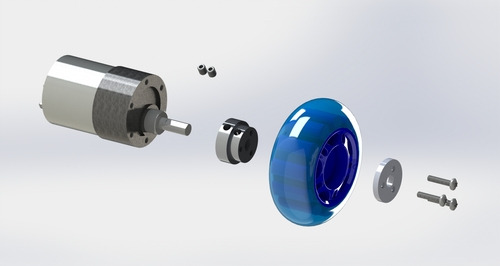 |
Exploded view of the scooter wheel adapter assembly with a gearmotor and scooter wheel. |
|---|
These adapters mount via set screw(s) to your motor’s output shaft (works best with D-shaped output shafts) and clamp tightly to the wheel.
|
|
|
We have versions of these adapters that support our gearmotors with 4 mm, 5 mm, and 6 mm shafts.
New version of the Zumo Shield for Arduino - now with full IMU!
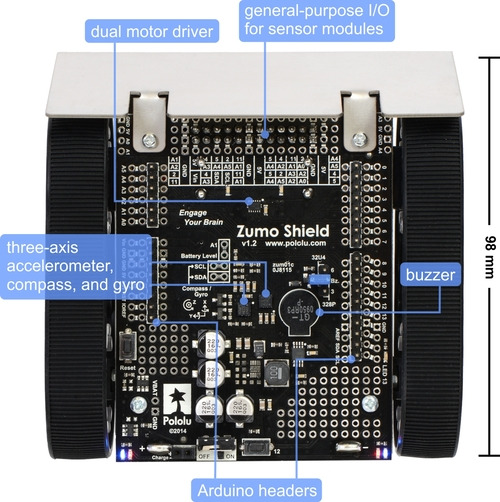 |
We posted recently about how progress in MEMS sensors has resulted in a constant stream of improved Pololu breakout boards. This week, we brought some of that technological progress to our Zumo robot with the release of a new “v1.2” version of the Zumo Shield for Arduino. This new version upgrades the previously-included LSM303DLHC compass to nine channels of inertial sensing using the newer LSM303D compass and L3GD20H gyroscope.
That means that the new Zumo shield includes a full inertial measurement unit (IMU) – the equivalent of a MinIMU-9 v3 – letting you turn it into a complete AHRS by adding an Arduino or compatible controller.
The v1.2 update extends to three new products:
- Zumo Shield for Arduino, v1.2
- Zumo Robot Kit for Arduino, v1.2 (No Motors)
- Zumo Robot for Arduino, v1.2 (Assembled with 75:1 HP Motors)
Other parts, such as the Zumo chassis, sumo blade, and reflectance sensor array, are not affected by this update, and the new Zumo shield is mechanically and electrically compatible with the previous model. They are also completely code-compatible except for the MEMS sensor aspects, which are already supported by our open-source Arduino libraries.
New product: AltIMU-10 v4 gyro, accelerometer, compass, and altimeter
Two weeks ago, we announced a big price reduction of our MEMS-based sensors and explained a little about why we release new versions of these boards so frequently. If you looked closely at the diagram showing the evolution of our ST MEMS sensor boards, you might have noticed that we’ve used each IC on a carrier board for that chip by itself, as well as on an IMU board combined with other sensors, with one exception: the LPS25H pressure sensor. When that post was written, we had recently released our LPS25H carrier, but we did not yet offer an IMU featuring this new barometer IC. The AltIMU-10 v3, which uses the older LPS331AP pressure sensor, was the newest AltIMU available from us at the time.
With the release of the AltIMU-10 v4 this week, that updated IMU is now available. Like the v3 version, the AltIMU-10 v4 contains an LSM303D three-axis magnetometer and accelerometer and an L3GD20H three-axis gyro, and it replaces the LPS331AP pressure sensor on the older board with the improved LPS25H, enabling pressure and altitude measurements with higher accuracy and lower noise.
We think the AltIMU-10 v4 combines the state of the art in ST’s MEMS sensors into one compact module at a great price. However, we’ve also put the AltIMU-10 v3 on clearance and lowered its price; if you don’t absolutely need ST’s newest pressure sensor on your IMU, the v3 is still a very good sensor board to consider.
Here’s an updated version of our diagram showing where the new AltIMU-10 fits in:
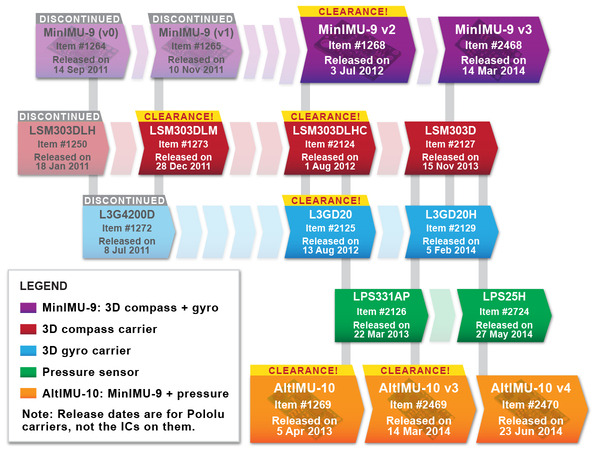 |
Evolution and release dates of Pololu carriers for ST’s MEMS sensors through June 2014. |
|---|
New product: CH Robotics UM7-LT orientation sensor
We’re now selling the UM7-LT orientation sensor, the latest Attitude and Heading Reference System (AHRS) from CH Robotics. The UM7 takes advantage of newer sensor technology to offer improved performance compared to its predecessor, the UM6, despite its reduced cost.
Like earlier CH Robotics AHRS modules, the UM7 contains an onboard microcontroller that combines data from its three-axis accelerometer, gyro, and magnetometer to produce orientation estimates 500 times a second. The attitude and heading information, available in the form of Euler angles or quaternions, can either be streamed automatically or provided upon request through a TTL serial interface.
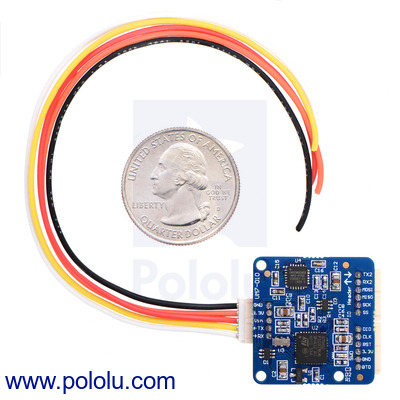 |
Power and serial connections can be made to the UM7-LT through a five-pin connector and an included matching cable, and expansion headers provide additional interfaces like SPI and a secondary UART that can be connected to an external GPS module. The free CHR Serial Interface software makes it easy to visualize data from the UM7 and configure its settings.
For more information about the UM7-LT, see its product page. A version of the UM7 with an enclosure, similar to the enclosed UM6, is expected to be available in the next few months.
